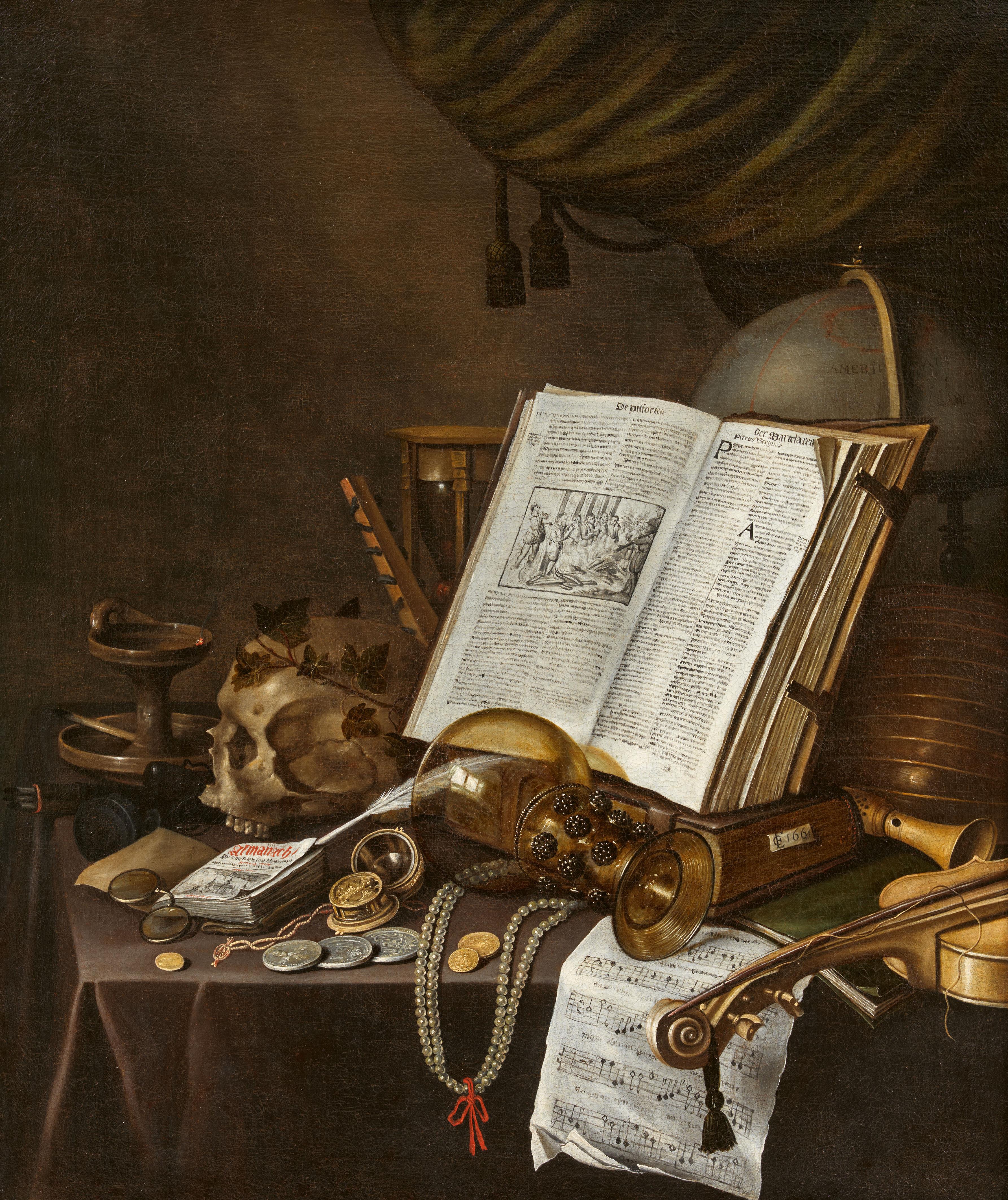Edwaert Collier
Vanitas Still Life
Oil on canvas. 91 x 76 cm.
Monogrammed and dated lower right on the book: EC 1661 (EC conjoined).
This portrait-format vanitas still life is an early masterpiece by Edwaert Collier. In this work, the artist explores for the first time a theme that he would return to again and again throughout his long career. Born in Breda, Collier moved to Haarlem, where his works met with great success. His Haarlem compositions reveal the clear influence of the city's leading still-life painter, Pieter Claesz. (1597-1660). Before he was admitted to the Guild of St Luke in 1664, Collier may have trained under Vincent Laurensz. van der Vinne (1628-1702), whose work is also influenced by the art of Pieter Claesz.
A central and recurring element in Collier's vanitas still lifes is the skull. When the Fine Arts Museum of San Francisco sold the present painting, the skull, crowned with a laurel wreath, was still overpainted with a vase adorned with laurel leaves. During the later cleaning in 1985, the vase was removed and the skull underneath was exposed. We encounter it again in a vanitas still life by the artist from 1661, which is in the collection of the Sinebrychoff Art Museum in Helsinki. Other vanitas still lifes can be found in the collections of the Rijksmuseum, Amsterdam and in the Metropolitan Museum of Art.
Collier's composition is based on a vanitas still life by Pieter Claesz. dated 1655, which was on the art market in 2001 (Sotheby's, New York, 25th January 2001, lot 159). His painting, made six years later, uses the main elements of the model, even taking into account the placement and appearance of the signature as well as the date. However, Collier adds new pictorial elements: a green silk curtain replaces the column that Claesz. inserted in the upper right. The contents of the open book in the centre of the picture have been changed and show a page from the Amsterdam edition of 1634 of Adriaen Cornelisz. van Haemstede's "Historien der Vromer Martelaren" (History of the Faithful Martyrs). The title page of the same book also appears in some still lifes by Claesz. possible teacher van der Vinne. Other elements such as the globe in the background, the sheet music, the coins and the almanac are taken from the model. Each of these pictorial elements is intended to remind the viewer of the transience of life: the hourglass and the pocket watch refer to the inexorable passage of time. The instruments and the score imply a connection between the fleeting nature of music and time itself. Similarly, the earthenware candlestick, with a single burning ember resting on its rim, represents the extinction of life, while the books and globe refer to the limits of earthly knowledge. The overturned rummer can be interpreted as a warning against intemperance.
Provenance
Michael de Young Collection, San Francisco, 1894. - M. H. de Young Memorial Museum ("The Young"), San Francisco. - Fine Arts Museums, San Francisco (inv. no. BL84.55). - Christie's, New York, 15 January 1985, lot 33. - Galerie Gismondi, Paris, 1986. - Private collection, Switzerland. - Hotel de Ventes, Geneva, 11 March 2015 - Christie's Online, 30 July 2020, lot 16 - Private collection Guernsey C.I. (Great Britain).
Literature
E. Buijsen, L.P. Grijp und W.J. Hoogstedter: The Hoogsteder Exhibition of Music & Painting in the Golden Age, exhibition catalogue, Antwerp and The Hague, 1994, p. 179 & 180, Anmerkung 1 ("catalogue entry by Fred G. Meijer). - Ann Stone: Schätze im Keller? Eine Analyse der Sammlungsnutzung in Kunstmuseen. Rand G S, 2002. - M. Brunner-Bulst: Pieter Claesz: der Hauptmeister des Haarlemer Stillebens im 17. Jahrhundert. Kritischer Oeuvrekatalog, Lingen, 2004, p. 336. - M. Tuominen: The Still Lifes of Edwaert Collier (1642-1708), Dissertation, 2014, p. 43-44 & 269, illus. 95.

